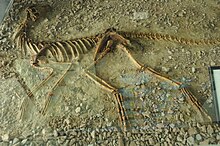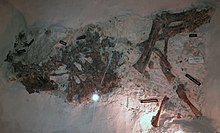| Silesaurus Temporal range: Late Triassic, Carnian PreꞒ Ꞓ O S D C P T J K Pg N | |
|---|---|

| |
| Reconstructed skeleton | |
| Scientific classification | |
| Domain: | Eukaryota |
| Kingdom: | Animalia |
| Phylum: | Chordata |
| Clade: | Dinosauria (?) |
| Clade: | †Ornithischia (?) |
| Family: | †Silesauridae |
| Clade: | †Sulcimentisauria |
| Genus: | †Silesaurus Dzik, 2003 |
| Species | |
| |
Silesaurus is a genus of silesaurid dinosauriform from the Late Triassic, of what is now Poland.
Discovery

Fossilized remains of Silesaurus have been found in the Keuper Claystone in Krasiejów near Opole, Silesia, Poland, which is also the origin of its name. The type species, Silesaurus opolensis, was described by Jerzy Dzik in 2003. It is known from some 20 skeletons, making it one of the best-represented species of early dinosauriformes.
Description

Silesaurus measured approximately 2.3 meters (7.5 feet) in length. Lightly built, it was probably a fast and agile animal with an active lifestyle. The snout was narrow with forward-pointing nostrils, and the large orbits likely provided Silesaurus with acute vision.
Initially, Silesaurus was thought to be strictly herbivorous, but later research on coprolite contents indicates that it may have been insectivorous, feeding on insects such as the beetle Triamyxa. The teeth of the animal were small, conical, and serrated, and were distributed irregularly in its jaws. The tip of the dentary had no teeth, and evidence suggests that it was covered by a keratinous beak.
Classification
Scientists think that Silesaurus was not a dinosaur, but rather a dinosauriform. Dinosaurian features lacking in Silesaurus include an enlarged deltopectoral crest (a muscle attachment on the humerus), and epipophyses (enlarged tendon attachment above the postzygapophysis) on the cervical vertebrae.
However, Silesaurus has some dinosaurian characteristics as well:
- a brevis shelf (a bone surface on the ilium that functions as an attachment site for tail muscles)
- ischium with a slender shaft
- femur with a reduced tuberosity that borders the ligament of the femoral head
- a prominent lesser trochanter
- an overlap of the ascending process of the astragalus with the tibia
- a concave proximal articular surface for the reception of the distal end of the fibula on the calcaneum
As a result, alternative hypotheses place Silesaurus at or near the base of the ornithischian dinosaurs. Other scientists propose a basal link between the basal sauropodomorphs and ornithischians.


Systematic position after Nesbitt (2011):
| Ornithodira |
| ||||||||||||||||||||||||||||||||||||||||||||||||||||||||||||||||||||||||
Palaeobiology

Diet
Herbivory has been suggested for silesaurids in general and Silesaurus in particular based on tooth shape, and a 2014 study by the paleontologists Tai Kubo and Mugino O. Kubo of microwear on its teeth found it consistent with herbivory on soft objects, by comparing with wear on the teeth of extant mammals, though omnivory could not be ruled out.
A 2019 study by paleontologist Martin Qvarnström and colleagues examining coprolites (fossil dung) that contained beetles attributed them to Silesaurus based on size and other factors. These researchers suggested that while Silesaurus could exploit plant resources, it was not strictly a plant-eater. They pointed out that the teeth of Silesaurus were not numerous or regularly spaced, and lacked the coarse serrations typical in herbivores. They hypothesized that the beak-like jaws were adapted for pecking small insects off the ground like modern birds. They cautioned that there could have been other food sources that were not preserved in the coprolites, such as soft prey, plant fragments, and larger, more resistant items that were regurgitated, and that beetles could have been a seasonal food item. If so, this would represent the earliest known occurrence of this highly derived mode of feeding and have implications for the understanding of the evolutionary adaptations that would eventually lead up to the origin of dinosaurs.
Locomotion

Silesaurus and silesaurids in general have been considered quadrupedal due to their long, gracile forelimbs. In 2010, the paleontologists Rafał Piechowski and Jerzy Dzik considered such proportions typical of fast-running, quadrupedal animals, but noted that the long tail of Silesaurus which would have acted as a counterweight to the body, as well as the very gracile forelimbs, indicates it retained the ability for fast bipedal running. Piechowski and the paleontologist Mateusz Tałanda concluded in 2020 that the short hindlimbs combined with the elongated forelimbs supported the idea that it was an obligate quadruped.
Palaeoenvironment
Silesaurus lived in a subtropical environment similar to the modern Mediterranean basin with alternating summer monsoons and dry winters. The animal shared its environment of extensive swamplands and fern vegetation with a wealth of invertebrates as well as dipnoan and ganoid fishes, temnospondyls, phytosaurs and early pterosaurs.
References
- ^ Dzik J (2003). "A beaked herbivorous archosaur with dinosaur affinities from the early Late Triassic of Poland" (PDF). Journal of Vertebrate Paleontology. 23 (3): 556–574. doi:10.1671/a1097. S2CID 128580897.
- Martin Qvarnström; Joel Vikberg Wernström; Rafał Piechowski; Mateusz Tałanda; Per E. Ahlberg; Grzegorz Niedźwiedzki (2019). "Beetle-bearing coprolites possibly reveal the diet of a Late Triassic dinosauriform". Royal Society Open Science. 6 (3): Article ID 181042. Bibcode:2019RSOS....681042Q. doi:10.1098/rsos.181042. PMC 6458417. PMID 31031991.
- Nesbitt, Sterling J. (2011). "The Early Evolution of Archosaurs: Relationships and the Origin of Major Clades". Bulletin of the American Museum of Natural History. 352: 1–292. doi:10.1206/352.1. hdl:2246/6112. S2CID 83493714.
- Kubo, Tai; Kubo, Mugino (2013). "Dental microwear of a Late Triassic dinosauriform, Silesaurus opolensis". Acta Palaeontologica Polonica. doi:10.4202/app.2013.0027. S2CID 55024625.
- Qvarnström, Martin; Wernström, Joel Vikberg; Piechowski, Rafał; Tałanda, Mateusz; Ahlberg, Per E.; Niedźwiedzki, Grzegorz (2019). "Beetle-bearing coprolites possibly reveal the diet of a Late Triassic dinosauriform". Royal Society Open Science. 6 (3): 181042. Bibcode:2019RSOS....681042Q. doi:10.1098/rsos.181042. PMC 6458417. PMID 31031991.
- Piechowski, Rafał; Dzik, Jerzy (2010). "The axial skeleton of Silesaurus opolensis". Journal of Vertebrate Paleontology. 30 (4): 1127–1141. doi:10.1080/02724634.2010.483547. S2CID 86296113.
- Piechowski, Rafał; Tałanda, Mateusz (2020). "The locomotor musculature and posture of the early dinosauriform Silesaurus opolensis provides a new look into the evolution of Dinosauromorpha". Journal of Anatomy. 236 (6): 1044–1100. doi:10.1111/joa.13155. PMC 7219628. PMID 32003023.
- John W. M. Jagt, Grzegorz Hebda, Sławomir Mitrus, Elena Jagt-Yazykova, Adam Bodzioch, Dorota Konietzko-Meier, Klaudia Kardynał, Kamil Gruntmejer. 2015. Field Guide, Conference Paper, European Association of Vertebrate Palaeontologists XIII Annual Meeting.
| Taxon identifiers | |
|---|---|
| Silesaurus opolensis | |


